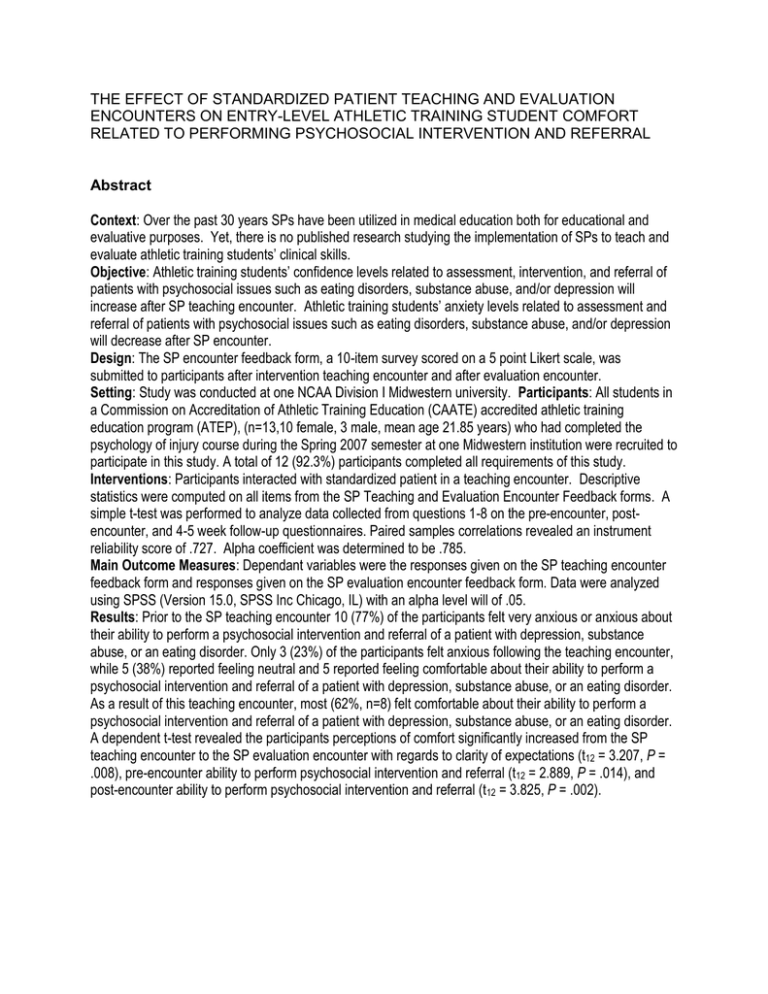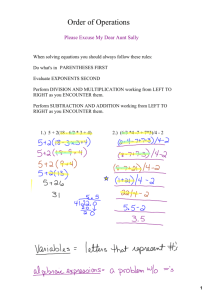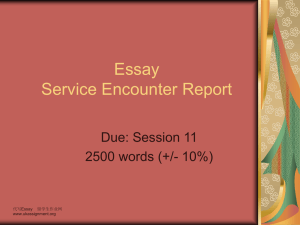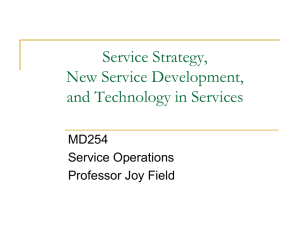THE EFFECT OF STANDARDIZED PATIENT TEACHING AND EVALUATION
advertisement

THE EFFECT OF STANDARDIZED PATIENT TEACHING AND EVALUATION ENCOUNTERS ON ENTRY-LEVEL ATHLETIC TRAINING STUDENT COMFORT RELATED TO PERFORMING PSYCHOSOCIAL INTERVENTION AND REFERRAL Abstract Context: Over the past 30 years SPs have been utilized in medical education both for educational and evaluative purposes. Yet, there is no published research studying the implementation of SPs to teach and evaluate athletic training students’ clinical skills. Objective: Athletic training students’ confidence levels related to assessment, intervention, and referral of patients with psychosocial issues such as eating disorders, substance abuse, and/or depression will increase after SP teaching encounter. Athletic training students’ anxiety levels related to assessment and referral of patients with psychosocial issues such as eating disorders, substance abuse, and/or depression will decrease after SP encounter. Design: The SP encounter feedback form, a 10-item survey scored on a 5 point Likert scale, was submitted to participants after intervention teaching encounter and after evaluation encounter. Setting: Study was conducted at one NCAA Division I Midwestern university. Participants: All students in a Commission on Accreditation of Athletic Training Education (CAATE) accredited athletic training education program (ATEP), (n=13,10 female, 3 male, mean age 21.85 years) who had completed the psychology of injury course during the Spring 2007 semester at one Midwestern institution were recruited to participate in this study. A total of 12 (92.3%) participants completed all requirements of this study. Interventions: Participants interacted with standardized patient in a teaching encounter. Descriptive statistics were computed on all items from the SP Teaching and Evaluation Encounter Feedback forms. A simple t-test was performed to analyze data collected from questions 1-8 on the pre-encounter, postencounter, and 4-5 week follow-up questionnaires. Paired samples correlations revealed an instrument reliability score of .727. Alpha coefficient was determined to be .785. Main Outcome Measures: Dependant variables were the responses given on the SP teaching encounter feedback form and responses given on the SP evaluation encounter feedback form. Data were analyzed using SPSS (Version 15.0, SPSS Inc Chicago, IL) with an alpha level will of .05. Results: Prior to the SP teaching encounter 10 (77%) of the participants felt very anxious or anxious about their ability to perform a psychosocial intervention and referral of a patient with depression, substance abuse, or an eating disorder. Only 3 (23%) of the participants felt anxious following the teaching encounter, while 5 (38%) reported feeling neutral and 5 reported feeling comfortable about their ability to perform a psychosocial intervention and referral of a patient with depression, substance abuse, or an eating disorder. As a result of this teaching encounter, most (62%, n=8) felt comfortable about their ability to perform a psychosocial intervention and referral of a patient with depression, substance abuse, or an eating disorder. A dependent t-test revealed the participants perceptions of comfort significantly increased from the SP teaching encounter to the SP evaluation encounter with regards to clarity of expectations (t12 = 3.207, P = .008), pre-encounter ability to perform psychosocial intervention and referral (t12 = 2.889, P = .014), and post-encounter ability to perform psychosocial intervention and referral (t12 = 3.825, P = .002).





